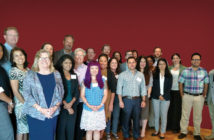James Sandos, history professor and the Farquhar Professor of the American Southwest, still visits archives and libraries for research. However, the recent shift to electronic records has changed the way he gets much of his material.
“The basic rhyme and reason behind all of my research has been to try to find a way to give a voice to those who don’t have one—to those traditionally excluded from the master narrative,” he says. “That means I have to be more resourceful about the sources I accept.”
Fortunately, the digital age has produced a wealth of sources along with the technological tools to better understand them.
When the Early California Population Project posted records online from 21 California missions—covering baptisms, marriages, deaths, family connections, and notes on local Indians—Sandos saw an opportunity to portray the information visually.
He and his wife, Tish, who is adept at working with databases, collaborated on a mapping project using the power of Geographic Information Systems (GIS) software.
“By looking at the information dynamically on a map, you see the associations and you begin to understand resentments and why people did certain things,” he says. “This kind of presentation was crucial to the explanation. It’s a whole new way to tell stories.”
Sandos received a KECK Foundation LENS (LEarNing Spatially) Fellowship in 2012 and worked with Steve Moore and the Center for Spatial Studies team to employ GIS tools in his classroom. For his California Indian Seminar, students were guided through the process of database mapping and presenting. Now, Sandos and Moore hope to get funding for a project to help California fourth graders studying the history of missions in the state.
“There is a tendency for students to be assigned to make a model of a mission. But if you make a building, you don’t have to talk about people,” Sandos says. “To get the people and the Native American back in the mission, the plan is to have a child create an image of his or herself, then create the native image, so they don’t have just a priest and a cluster of faceless natives.”
When he retires at the end of the 2017 academic year, Sandos will have spent two decades as the Farquhar Professor of the American Southwest. The professorship allowed him to do research that led to Rancho Camulos being officially designated as the “Home of Ramona;” to write two essays for a prestigious four-volume set on California history; and, to have Yale University Press publish his book Converting California.
While he won’t be a full-time faculty member, Sandos, who is finishing a tome on Indian violence against the missions, will continue to teach his California Indian Seminar at the University of Redlands.
—Catherine Garcia ’06



